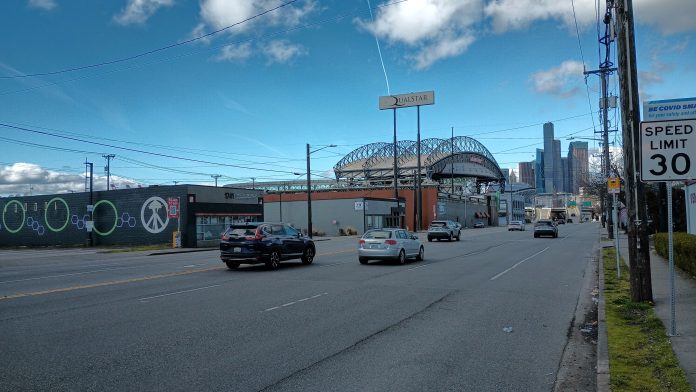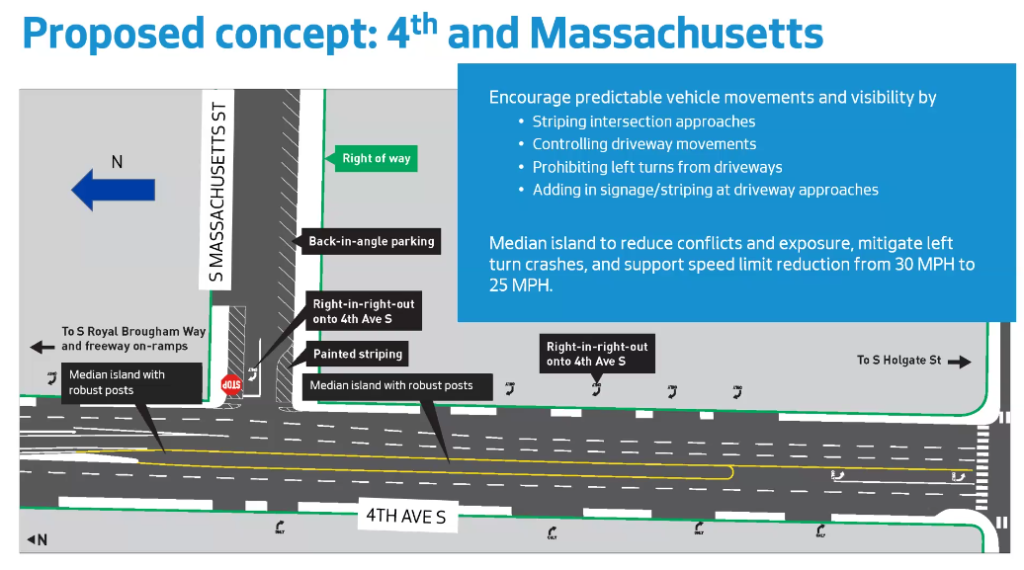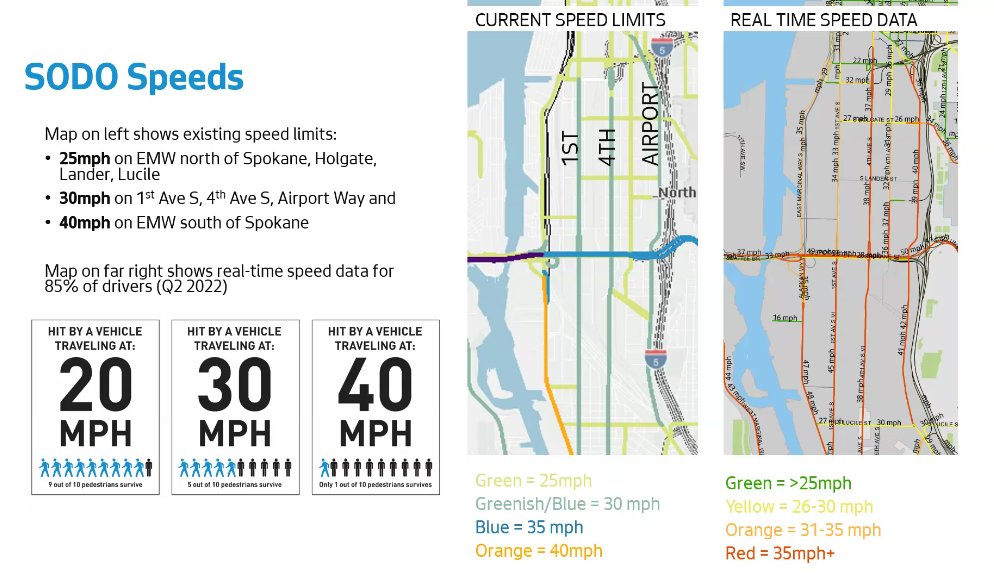
Last year, the Seattle Department of Transportation (SDOT), following a series of high-profile traffic deaths in the SoDo neighborhood, announced they would be making immediate moves to improve traffic safety near 4th Avenue S and S Holgate Street. At the time, the quarter-mile vicinity around that intersection had seen a full 10% of all citywide traffic fatalities since the beginning of 2020, with seven people killed, most of whom were walking or biking.
The improvements proposed were incredibly modest, and would stop short of a full rechannelization of seven-lane 4th Avenue. They included a closure of the center turn lane near Massachusetts Street, with all driveways north of Holgate Street converted into “right-in-right-out” operation, as well as added parking restrictions near the intersection along Massachusetts to increase visibility. The speed limit on the street was also proposed to be dropped from 30 mph to 25 mph, matching unsigned arterial streets in the rest of the city.

Restricting left turns into driveways and making right turns out of them more predictable would likely benefit people walking or biking on the sidewalk on 4th Avenue, where SDOT data shows most drivers exceed the 30 mph speed limit. Last July, a driver killed International District resident Gan Hao Li while making a turn out of one of the parking lots along this exact stretch, just a few months after another driver killed Antonio Tiongco, another cyclist, just a few blocks away at 3rd Avenue and Holgate Street.
However, those improvements, framed directly as a “rapid response” to worsening conditions in SoDo, still have not gone into place.
Originally intended to be in place by last fall with an evaluation period to follow, the project has been held up by requests for more study around how the changes would impact freight mobility and business access.
“They talk about how they want to do interim changes, it gets pushed back, and then it just halts,” Erica Bush, co-lead of Duwamish Valley Safe Streets, a member organization of the Seattle Neighborhood Greenways coalition, told The Urbanist. Bush says they have been successful in moving forward with some street safety projects in Georgetown and South Park, but not in SoDo.
“Within SoDo, we have seen no on-the-ground treatments, which is what we’ve been asking for for two and a half years. There have been all these little attempts…but we’re always told, ‘we need to study it further’,” Bush said. “SDOT needs to be more bullish.”
Leadership at the SoDo Business Improvement Area (BIA), an advocacy group funded by a tax on businesses in the neighborhood, raised questions about the rapid response improvements when they were first presented to the city’s freight advisory board last July. There appears to be broad agreement that SoDo needs street upgrades, but not what those improvements should be.
“SoDo is suffering from failed infrastructure,” the SoDo BIA’s executive director, Erin Goodman, said following a presentation on the proposal at that meeting, noting that the BIA had been trying for years to get sidewalks installed on S Holgate Street. “I think that we need to look at the whole SoDo holistically and look at trying to fix the entire process, rather than this spot check, which…may not actually prevent any of the fatalities in this area. I really want to make sure that we’re doing that in-depth research,” she said.
Holgate sidewalks were one element of a nearly $30 million grant request from the U.S. Department of Transportation last year, which SDOT was successful in securing nearly all of via a $25.6 million award.
But as the city does that additional study, the safety crisis in SoDo, and on 4th Avenue S in particular, hasn’t abated since last year. Just this weekend, a 27-year-old driver was killed when he was involved in a crash with another driver at S Massachusetts Street and he became trapped in his vehicle. Just a week before that, on March 16, a 40-year-old woman was hit and killed while walking a few blocks south at S Lander Street, in a hit-and-run. The driver in that crash has still not been identified.
A clear reason that SoDo remains a hot spot for deadly crashes is vehicle speeds, exacerbated by the incredibly wide roads that cut through the industrial neighborhood. Data presented to the freight board showed most drivers in the neighborhood are exceeding posted speed limits, most substantially on the long, north-south corridors like 1st Avenue S and 4th Avenue S. Data collected in the area around 4th Avenue and Holgate showed that most drivers were traveled around 37 mph despite the 30 mph posted speed. As speeds increase from 30 mph to 40 mph, the likelihood of a pedestrian surviving a crash with a vehicle goes from 50% to 10%. It is not likely restricting turns will have a big impact on vehicle speeds, but turn maneuvers come with added risk when vehicle speeds remain this high.

SDOT spokesperson Ethan Bergerson told The Urbanist that the department is moving forward with the rapid response improvements this year: “This project has been approved and is currently being designed for construction in 2023. We are continuing to engage with stakeholders in SODO and coordinate with other neighborhood projects led by both SDOT and other transportation agencies. This spring, we’ll conduct additional outreach with organizations like the SODO Business Improvement Area and Duwamish Valley Safe Streets, as well as individual stakeholders in the project area.”
Bergerson noted that they’ve added a few additional elements including a bus bulb at 4th Avenue and S Holgate. Signalized intersections will be programmed with leading pedestrian intervals, which give pedestrians a slight head-start at a green light, which have been successful elsewhere in the city in reducing pedestrian-involved crashes. He also acknowledged that this project reflects how the department delivers projects elsewhere.
“We are also continuing to refine our internal process for quicker implementation of safety improvements across the city, particularly in areas with the greatest need like SODO,” Bergerson said. “The Vision Zero Top-To-Bottom Review highlighted this need and included recommendations like installing safety improvements earlier in a project’s timeline instead of waiting for other project elements to be completed.”
He pointed to the Beacon Hill protected bike lane, which is being expanded to a full corridor safety project, with speed humps and other traffic calming features planned for 15th Avenue S sooner than the implementation of the full project.
In the case of 4th Avenue S in SoDo, however, a reluctance to implement small changes that could have an oversized impact on safety, even as a pilot program that could be removed if it wasn’t proving effective, points to larger barriers toward making streets through the city’s busiest industrial neighborhoods safer for everyone.
Ryan Packer has been writing for The Urbanist since 2015, and currently reports full-time as Contributing Editor. Their beats are transportation, land use, public space, traffic safety, and obscure community meetings. Packer has also reported for other regional outlets including BikePortland, Seattle Met, and PubliCola. They live in the Capitol Hill neighborhood of Seattle.

